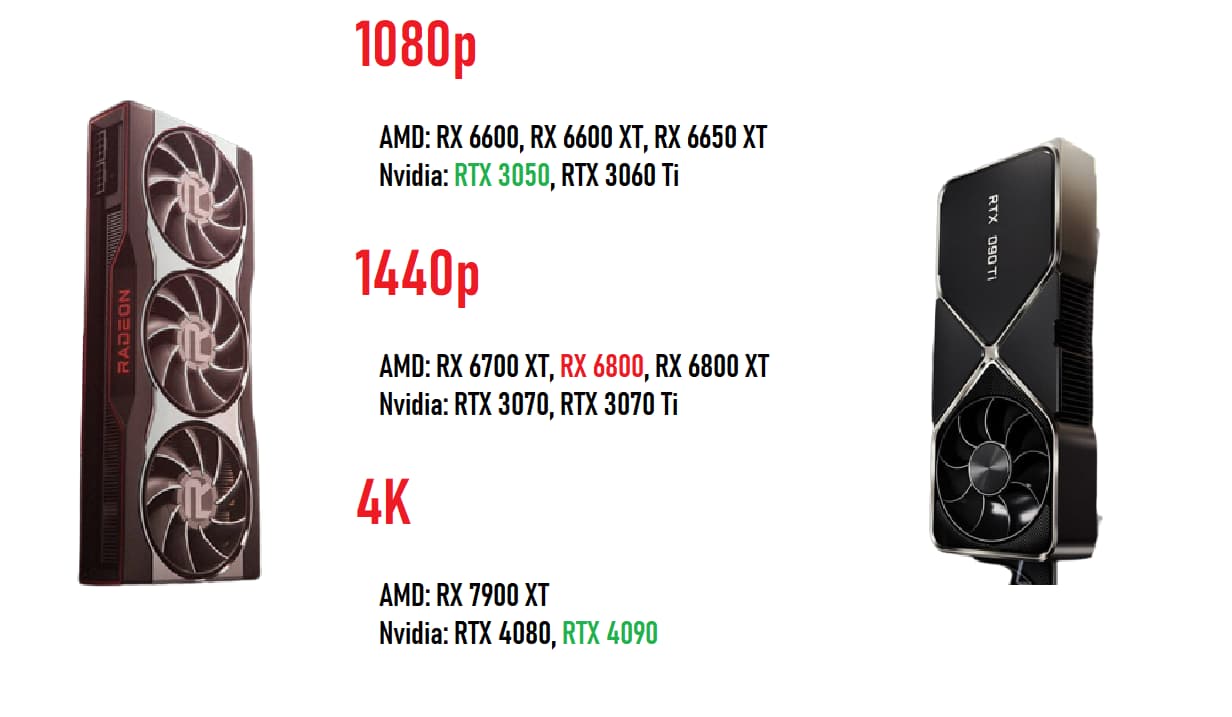The eternal debate rages on – which makes better graphics cards for gaming, AMD or Nvidia? I’m going to break down the key differences between the two GPU giants to help you decide which brand you should buy for your next upgrade.
How Are AMD and Nvidia GPUs Different?
While AMD and Nvidia take different approaches to GPU design, they both make hardware optimized for 3D graphics and video gaming. Some key differences:
- Ray Tracing: Nvidia focuses heavily on ray tracing with dedicated RT cores. AMD relies on standard shading units.
- AI Upscaling: Nvidia’s DLSS uses AI to upscale images. AMD’s FSR is a simpler spatial upscaling.
- New Features: Nvidia rapidly rolls out new technologies like DLSS 3 frame generation. AMD sometimes lags behind.
- Connectivity: AMD supports DisplayPort 2.1 for extra bandwidth. Nvidia sticks with DP 1.4.
Nvidia GPUs – Pros and Cons
Key Strengths
- Superior ray tracing performance
- AI-enhanced upscaling with DLSS produces incredible image quality
- Early access to new graphics features like DLSS 3 frame generation
- GeForce Experience software offers easy optimization
Weaknesses
- Prices on high-end models are very inflated
- VRAM capacity on mid-range cards can be lacking (RTX 4060 Ti has just 8GB)
AMD GPUs- Pros and Cons
Key Strengths
- Excellent value across the product stack
- More VRAM than Nvidia counterparts at same price points
- Leverage open standards like FSR that work across all hardware
Weaknesses
- Ray tracing and upscaling lag behind Nvidia’s solutions
- Drivers and software not as refined as Nvidia’s offerings
Direct Performance Comparison
Benchmarks reveal that the latest Nvidia RTX 40 series convincingly beats Radeon RX 7000 cards in traditional rasterization and ray tracing performance.
However, AMD GPUs offer tremendous price/performance value. The RX 7900 XT nearly matches the RTX 4080 for over $200 less. And the RX 6700 XT beats the RTX 4060 Ti in many games despite costing significantly less.
So if you want the utmost gaming performance regardless of cost, Nvidia is superior. But AMD gives you excellent bang for your buck.
Which is Better for Competitive Multiplayer Games?
For fast-paced online multiplayer titles like Apex Legends, Fortnite, CSGO, etc. raw frame rates are more important than cutting-edge graphics.
Both AMD and Nvidia cards will deliver extremely high FPS when paired with a suitable CPU. Features like ray tracing and DLSS also aren’t as useful in competitive gaming.
So for eSports, you can’t go wrong with either brand. Focus on getting the best GPU you can afford from Nvidia or AMD to maximize frame rates.
Which is Better for Single Player AAA Games?
For cinematic single player games that push graphics to the limit, Nvidia has some clear advantages:
- Higher performance in ray traced titles (RTX 4080 is ~25% faster than RX 7900 XT)
- DLSS 3 frame generation boosts FPS significantly
- More memory capacity on high-end cards like RTX 4090
However, AMD still runs new games very well. Unless you’re gaming at 4K resolution, an AMD card will still deliver smooth frame rates with maxed settings in most titles.
I’d only recommend splurging on Nvidia’s most premium GPUs if you want to crank every graphics setting to the absolute max.
Recommendations By Resolution
Based on their pricing and performance characteristics, here are my quick picks for the best AMD and Nvidia GPUs for popular resolutions:
1080p
- AMD: RX 6600, RX 6600 XT, RX 6650 XT
- Nvidia: RTX 3050, RTX 3060 Ti
1440p
- AMD: RX 6700 XT, RX 6800, RX 6800 XT
- Nvidia: RTX 3070, RTX 3070 Ti
4K
- AMD: RX 7900 XT
- Nvidia: RTX 4080, RTX 4090
Either brand offers competitive options for any resolution. Go with the best deal you can find on a suitable card for your monitor.
The Verdict – It’s a Tough Call!
Ultimately, there are great graphics cards available from both AMD and Nvidia. Key deciding factors will be:
- Your budget – AMD offers better value for money
- If you value ray tracing and newest features – Lean Nvidia
- The types of games you play – AMD is perfectly capable for most
- Your target resolution – Higher resolution favors Nvidia
Ideally, take a look at benchmark results for the specific GPU models you’re considering. Pick whichever card delivers the frame rates, visuals, and features you want for the price you can afford.
You really can’t go wrong buying a modern GPU from either Team Red or Team Green for gaming! Let me know which brand you think offers the better graphics cards. I’m eager to hear your opinions on AMD vs Nvidia!















